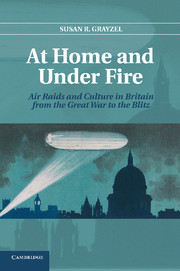Description
At Home and under Fire
Air Raids and Culture in Britain from the Great War to the Blitz
Author: Grayzel Susan R.
This book demonstrates how the legacy of Britain's first air raids helped prepare civilians for the Second World War.
Language: English
Subject for At Home and under Fire:
Approximative price 56.06 €
In Print (Delivery period: 14 days).
Add to cart
At Home and under Fire
Publication date: 02-2014
Support: Print on demand
Publication date: 02-2014
Support: Print on demand
Approximative price 118.92 €
In Print (Delivery period: 14 days).
Add to cart
At home and under fire: air raids and culture in britain from the great war to the blitz
Publication date: 01-2012
356 p. · 15.2x22.9 cm · Hardback
Publication date: 01-2012
356 p. · 15.2x22.9 cm · Hardback
Description
/li>Contents
/li>Biography
/li>
Although the Blitz has come to symbolize the experience of civilians under attack, Germany first launched air raids on Britain at the end of 1914 and continued them during the First World War. With the advent of air warfare, civilians far removed from traditional battle zones became a direct target of war rather than a group shielded from its impact. This is a study of how British civilians experienced and came to terms with aerial warfare during the First and Second World Wars. Memories of the World War I bombings shaped British responses to the various real and imagined war threats of the 1920s and 1930s, including the bombing of civilians during the Spanish Civil War and, ultimately, the Blitz itself. The processes by which different constituent bodies of the British nation responded to the arrival of air power reveal the particular role that gender played in defining civilian participation in modern war.
1. Modern war and the militarization of domestic life; 2. Destroying the innocent: the arrival of the air raid, 1914–16; 3. Redefining the battlezone: responding to intensified aerial warfare, 1917–18; 4. Writing and rewriting modern warfare: memory, representation, and the legacy of the air raid in interwar Britain; 5. Inventing civil defense: imagining and planning for the war to come; 6. Trying to prevent the war to come: efforts to remove the threat of air raids; 7. Facing the future of air power: responding to interwar air raids; 8. Preparing the public for the next war: the expansion of air raid precautions; 9. Protecting the innocent: gas masks and the domestication of air raid precautions; 10. Responding to the air war's return: the militarized domestic sphere from Munich to the Blitz; 11. Representing the new air war: morale and the domestication of the air raid in wartime popular culture; 12. Conclusion: air raids and the domestication of modern war.
Susan Grayzel is the author of Women's Identities at War: Gender, Motherhood, and Politics in Britain and France during the First World War (1999), which was awarded the 2000 British Council Prize of the North American Conference of British Studies, and Women and the First World War (2002). She co-edited Gender, Labor, War and Empire: Essays on Modern Britain with Philippa Levine, published in 2009. Currently, Grayzel is a Professor of History at the University of Mississippi.
© 2024 LAVOISIER S.A.S.




